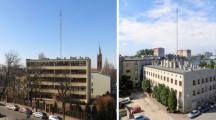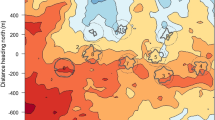Abstract
Higher-order moments, minima and maxima of turbulent temperature and water vapour mixing ratio probability density functions measured with an eddy-covariance system near the ground were related to each other and to vertical boundary-layer profiles of the same scalars obtained through airborne soundings. The dependence of kurtosis on squared skewness showed a kurtosis intercept below the Gaussian expectation, suggesting a compression of the probability density function by the presence of natural boundaries. This hypothesis was corroborated by comparing actual minima and maxima of turbulent fluctuations to estimates obtained from the first four sample moments by fitting a four-parameter beta distribution. The most sharply defined boundaries were found for the minima of temperature datasets during the day, indicating that negative temperature fluctuations at the sensor are limited by the availability of lower temperatures in the boundary layer. By comparison to vertical profiles, it could be verified that the turbulent minimum of temperature near the ground is close to the minimum of potential temperature in the boundary layer. The turbulent minimum of water vapour mixing ratio was found to be equal to the mixing ratio at a height above the minimum of the temperature profile. This height roughly agrees with the top of the non-local unstable domain according to bulk Richardson number profiles. We conclude that turbulence statistics measured near the surface cannot be solely explained by local effects, but contain information about the whole boundary layer including the entrainment zone.
Similar content being viewed by others

References
Alberghi S, Maurizi A, Tampieri F (2002) Relationship between the vertical velocity skewness and kurtosis observed during sea-breeze convection. J Appl Meteorol 41: 885–889
Andreas EA, Hill RJ, Gosz JR, Moore DI, Otto WD, Sarma AD (1998) Statistics of surface-layer turbulence over terrain with metre-scale heterogeneity. Boundary-Layer Meteorol 86: 379–408
Bogena H, Schulz K, Vereecken H (2006) Towards a network of observatories in terrestrial environmental research. Adv Geosci 9: 1–6
Castellvi F, Snyder RL, Baldocchi DD (2008) Surface energy-balance closure over rangeland grass using the eddy covariance method and surface renewal analysis. Agric For Meteorol 148: 1147–1160
Chatwin PC, Lewis DM, Sullivan PJ (1995) Turbulent dispersion and the beta distribution. Environmetrics 6: 395–402
Chu CR, Parlange MB, Katul GG, Albertson JD (1996) Probability density functions of turbulent velocity and temperature in the atmospheric surface layer. Water Resour Res 32: 1681–1688
de Arellano JVG, Gioli B, Miglietta F, Jonker HJJ, Baltink HK, Hutjes RW, Holtslag AAM (2004) Entrainment process of carbon dioxide in the atmospheric boundary layer. J Geophys Res 109: D18110
Detto M, Katul GG (2007) Simplified expressions for adjusting higher-order turbulent statistics obtained from open path gas analyzers. Boundary-Layer Meteorol 122: 205–216
Effelsberg E, Peters N (1983) A composite model for the conserved scalar PDF. Combust Flame 50: 351–360
Ek M, Mahrt L (1994) Daytime evolution of relative humidity at the boundary layer top. Mon Weather Rev 122: 2709–2721
Gryanik V, Hartmann J (2002) A turbulence closure for the convective boundary layer based on a two-scale mass-flux approach. J Atmos Sci 59: 2729–2744
Johnson NL, Kotz S, Balakrishnan N (1995) Continuous univariate distributions vol 2, 2nd edn. Wiley, New York, pp 719
Katul G, Goltz SM, Hsieh CI, Cheng Y, Mowry F, Sigmon J (1995) Estimation of surface heat and momentum fluxes using the flux-variance method above uniform and non-uniform terrain. Boundary-Layer Meteorol 74: 237–260
Kendall MG, Stuart A (1958) The advanced theory of statistics: Vol. 1, distribution theory. Griffin, London, pp 431
Kowalski A, Serrano-Ortiz P (2007) On the relationship between the eddy covariance, the turbulent flux, and surface exchange for a trace gas such as CO2. Boundary-Layer Meteorol 124: 129–141
Lewis DM, Chatwin PC, Mole N (1997) Investigation of the collapse of the skewness and kurtosis exhibited in atmospheric dispersion data. Nuovo Cimento C 20: 385–398
Liebethal C, Foken T (2003) On the significance of the Webb correction to fluxes. Boundary-Layer Meteorol 109: 99–106
Mahrt L (1989) Intermittency of atmospheric turbulence. J Atmos Sci 46: 79–95
Mahrt L (1991) Boundary-layer moisture regimes. Q J Roy Meteorol Soc 117: 151–176
Mauder M, Foken T, Clement R, Elbers JA, Eugster W, Grünwald T, Heusinkveld B, Kolle O (2008) Quality control of CarboEurope flux data—Part 2: inter-comparison of eddy-covariance software. Biogeosciences 5: 451–462
Maurizi A (2006) On the dependence of third- and fourth-order moments on stability in the turbulent boundary layer. Nonlinear Proc Geophys 13: 119–123
Moene AF, Michels BI (2002) Estimation of the statistical error in large eddy simulation results. 15–19 July 2002, Wageningen. American Meteorological Society, Boston, p 3.12
Moene AF, Schüttemeyer D, Hartogensis OK (2006a) Scalar similarity functions: the influence of surface heterogeneity and entrainment. 22–25 May 2006, San Diego. American Meteorological Society, Boston, p 5.1
Moene AF, Michels BI, Holtslag AAM (2006b) Scaling variances of scalars in a convective boundary layer under different entrainment regimes. Boundary-Layer Meteorol 120: 257–274
Moene AF, Schüttemeyer D (2008) The effect of surface heterogeneity on the temperature-humidity correlation and the relative transport efficiency. Boundary-Layer Meteorol 129: 99–113
Moeng CH, Wyngaard JC (1984) Statistics of conservative scalars in the convective boundary layer. J Atmos Sci 41: 3161–3169
Moore CJ (1986) Frequency response corrections for eddy correlation systems. Boundary-Layer Meteorol 37: 17–35
Munro RJ, Chatwin PC, Mole N (2003) A concentration pdf for the relative dispersion of a contaminant plume in the atmosphere. Boundary-Layer Meteorol 106: 411–436
Polster G, Geiß H, Heinemann K (1986) Der meteorologische Turm der Kernforschungsanlage Jülich, Berichte der Kernforschungsanlage Jülich Nr. 2095, ISSN 0366-0885, 31 pp
Price J (2001) A study of probability distributions of boundary-layer humidity and associated errors in parametrized cloud-fraction. Q J Roy Meteorol Soc 127: 739–758
Ramos FM, Bolzan MJA, Sa LDA, Rosa RR (2004) Atmospheric turbulence within and above an Amazon forest. Phys D 193: 278–291
Reitebuch O, Strassburger A, Emeis S, Kuttler W (2000) Nocturnal secondary ozone concentration maxima analysed by sodar observations and surface measurements. Atmos Environ 34: 4315–4329
Santanello JA, Friedl MA, Ek MB (2007) Convective boundary layer interactions with the land surface at diurnal time scales: diagnostics and feedbacks. J Hydrometeorol 8: 1082–1097
Scanlon TM, Sahu P (2008) On the correlation structure of water vapor and carbon dioxide in the atmospheric surface layer: A basis for flux partitioning. Water Resour Res 44: W10418. doi:10.1029/2008WR006932
Schmitgen S, Gei H, Ciais P, Neininger B, Brunet Y, Reichstein M, Kley D, Volz-Thomas A (2004) Carbon dioxide uptake of a forested region in southwest France derived from airborne CO2 and CO measurements in a quasi-Lagrangian experiment. J Geophys Res 109: D14. doi:10.1029/2003JD004335
Schopflocher TP, Smith CJ, Sullivan PJ (2007) Scalar concentration reduction in a contaminant cloud. Boundary-Layer Meteorol 122: 683–700
Schotanus P, Nieuwstadt FTM, de Bruin HAR (1983) Temperature-measurement with a sonic anemometer and its application to heat and moisture fluxes. Boundary-Layer Meteorol 26: 81–93
Stull RB (1993) Review of non-local mixing in turbulent atmospheres: transilient turbulence theory. Boundary-Layer Meteorol 62: 21–96
Sun XM, Zhu ZL, Wen XF, Yuan GF, Yu GR (2006) The impact of averaging period on eddy fluxes observed at ChinaFlux sites. Agric For Meteorol 137: 188–193
Taylor JR (1982) An introduction to error analysis. University Science Books, Mill Valley, pp 270
Tillman JE (1972) The indirect determination of stability, heat and momentum fluxes in the atmospheric boundary layer from simple scalar variables during dry unstable conditions. J Appl Meteorol 11: 783–792
Thomas C, Martin JG, Goeckede M, Siqueira MB, Foken T, Law BE, Loescher HW, Katul G (2008) Estimating subcanopy respiration from conditional sampling methods applied to multi-scalar high frequency time series. Agric For Meteorol 148: 1210–1229
van Dijk A, Moene AF, de Bruin, HAR (2004) The principle of surface flux physics: theory, practice and description of the ECPACK library. Internal report 2004/1, Meteorology and Air Quality Group, Wageningen University, Wageningen, The Netherlands, 99 pp
van Heerwaarden CC, de Arellano JVG (2008) Relative humidity as an indicator for cloud formation over heterogeneous land surfaces. J Atmos Sci 65: 3263–3277
Vickers D, Mahrt L (1997) Quality control and flux sampling problems for tower and aircraft data. J Atmos Ocean Technol 14: 512–526
Vickers D, Thomas C, Law BE (2009) Random and systematic CO2 flux sampling errors for tower measurements over forests in the convective boundary layer. Agric For Meteorol 149: 73–83
Voronovich V, Kiely G (2007) On the gap in the spectra of surface-layer atmospheric turbulence. Boundary-Layer Meteorol 122: 67–83
Webb EK, Pearman GI, Leuning R (1980) Correction of flux measurements for density effects due to heat and water-vapor transfer. Q J Roy Meteorol Soc 106: 85–100
Weber S, Graf A, Heusinkveld BG (2007) Accuracy of soil heat flux plate measurements in coarse substrates - Field measurements versus a laboratory test. Theor Appl Climatol 89: 109–114
Wendland F, Hannappel S, Kunkel R, Schenk R, Voigt HJ, Wolter R (2005) A procedure to define natural groundwater conditions of groundwater bodies in Germany. Water Sci Technol 51: 249–257
Wilczak JM, Oncley SP, Stage SA (2001) Sonic anemometer tilt correction algorithms. Boundary-Layer Meteorol 99: 127–150
Wyngaard JC, Tennekes H (1979) Measurements of the small-scale structure of turbulence at moderate reynolds numbers. Phys Fluids 13: 1962–1969
Yee E, Wilson DJ, Zelt W (2006) Probability distributions of concentration fluctuations of a weakly diffusive passive plume in a turbulent boundary layer. Boundary- Layer Meteorol 64: 321–354
Zhang Q, Stull RB (1992) Alternative nonlocal descriptions of boundary-layer evolution. J Atmos Sci 49: 2267–2281
Author information
Authors and Affiliations
Corresponding author
Rights and permissions
About this article
Cite this article
Graf, A., Schüttemeyer, D., Geiß, H. et al. Boundedness of Turbulent Temperature Probability Distributions, and their Relation to the Vertical Profile in the Convective Boundary Layer. Boundary-Layer Meteorol 134, 459–486 (2010). https://doi.org/10.1007/s10546-009-9444-9
Received:
Accepted:
Published:
Issue Date:
DOI: https://doi.org/10.1007/s10546-009-9444-9



